Hiddden Pairs | Master Sudoku: From Beginner to Expert - Class 1 PDF Download
Hidden Singles
Hidden singles are a simple enough concept, but are often quite hard to spot.
The definition of a hidden single is when a pencil mark is the only one of its kind in an entire row, column, or block.
For example, can you find one in the sample below?

This row must have a "7" in it somewhere, because in Sudoku all rows have a "7". If you look closely at the pencil marks, you will see only one cell that has a "7" as one of its candidates.
What does this mean? Simple. That cell must be the "7"! Erase all the other pencil marks, fill in the "7" with your pen, and erase any other "7" pencil marks in the same column or block (we already know there aren't any in that row!).
Similarly, the below sample shows there is only one "4" pencil mark in the entire block:
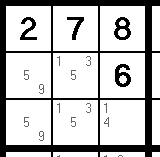
As I said, the problem with these guys is that they're hard to find! In order to perform an exhaustive search, you need to look at every row, column, and block, for each of the numbers, 1 through 9. This means nine rows, nine columns, and nine blocks (these are sometimes referred to as the 27 different "houses"), for nine different numbers. That's 243 (27 x 9) different searches!
The truth is, you wouldn't scan a row for a single "5" pencil mark if the row already had a "5" in it. Also, many times a "house" (row, column, or block) will only have two or three cells left to fill in, and then they are much easier to spot…
Computer programs can make this easier, as well. Sudoklue, for example, will highlight all the pencil marks of a given number if you press CTRL + [number].
See the screenshot below after I've pressed CTRL + 5:
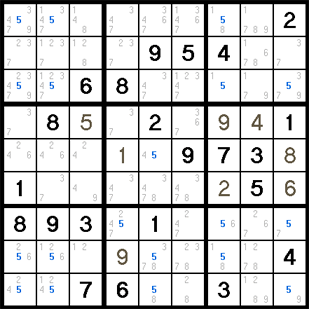
This makes the hidden single "5" in the center much easier to spot.
Hidden Pairs
A Hidden Pair is basically just a "buried" Naked Pair. It occurs when two pencil marks appear in exactly two cells within the same house (row, column, or block).
This time, however, the pair is not "Naked" - it is buried (or hidden) among other pencil marks.
For example: The picture below shows a block with many unsolved cells.
If we look closely, we can see that the two green cells are the only two that contain 6 & 9:
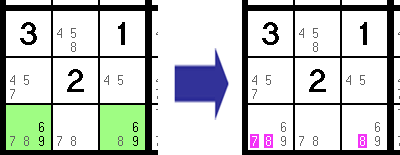
And for the moment, it does not matter which green cell is the 6 and which is the 9 - the point is that those cells can only be 6 or 9.
Since this is the case, we are free to erase all the other pencil marks in the green cells (erase the pink ones).
Hidden Pairs are another example of a relatively simple concept that is quite hard to spot in a puzzle.
For example, take a look at this row:

Hidden Triplets & Quads
As you may have guessed, Hidden Triplets work on the same concept as Hidden Pairs: When three given pencil marks appear in only three cells in any given row, column, or block, all other pencil marks may be removed from those cells.
In the example below, we see a block with only one cell solved and the rest of the cells pencil marked with all their possible candidates.
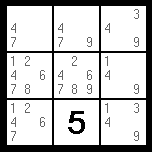
Now, if we study very closely, we can see that the three cells indicated in green (below) are the only cells that contain the pencil marks 2, 6 & 8.
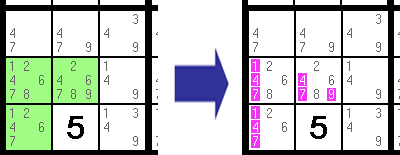
Since 2, 6 & 8 are only possible in three cells, we can conclude that those three cells must be some combination of 2, 6, and 8! We can safely erase all the other pencil marks in them (erase the pink ones).
You may have noticed that the "8" pencil mark only appears in two of the cells. That's fine. The rule still fits. In fact, it gives us even more information later. The fact of the matter is that 2, 6, & 8, as a "set", only appear in three cells. Three numbers; three cells.
Hidden Triplets are kind of hard, huh?: Well, the good news is this is the hardest of the "basic" techniques. And if you stopped here, you would still possess the skills to solve 95% of the Sudoku puzzles out there.
For the sake of being complete, there is one more technique I should mention real quick: Hidden Quads.
Similar to Hidden Pairs & Triplets, a Hidden Quad is when you find four different pencil marks inside only four cells in the same house. I should say, though, that these are extremely rare. It is quite possible that you will never even see one.
For this reason, I will not go too deeply into them. I'll just give you an example of one and leave it at that.
The puzzle below contains a "Hidden Quad". Can you find it? If you can't, don't be discouraged!
In fact, if this is discouraging you at all, feel free to scroll down and click "Next", and you will not be any worse off for it. As I said, you can probably go your whole life without ever needing this technique.
But if you like a good challenge, here it is…
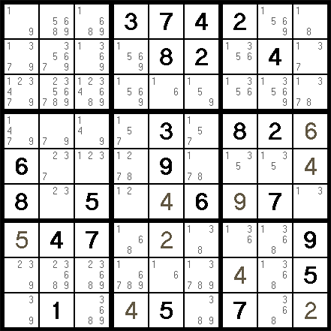
Hint: Hidden Quads only appear in houses with seven or more unsolved cells. The puzzle above has only two blocks, two rows, and three columns that meet that requirement.
|
9 videos|46 docs
|
FAQs on Hiddden Pairs - Master Sudoku: From Beginner to Expert - Class 1
| 1. What are Hidden Singles in Sudoku? |  |
| 2. How do Hidden Pairs work in Sudoku? |  |
| 3. What is the difference between Hidden Triplets and Hidden Quads in Sudoku? |  |
| 4. How can I identify Hidden Singles, Pairs, Triplets, and Quads in a Sudoku puzzle? |  |
| 5. Why are Hidden Techniques important for solving difficult Sudoku puzzles? |  |




















